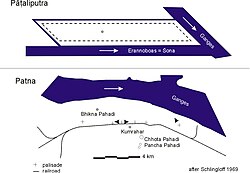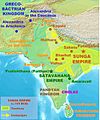This is an old revision of this page, as edited by Sitush (talk | contribs) at 13:00, 21 September 2016 (image is not reliable - created by the banned Jagged85). The present address (URL) is a permanent link to this revision, which may differ significantly from the current revision.
Revision as of 13:00, 21 September 2016 by Sitush (talk | contribs) (image is not reliable - created by the banned Jagged85)(diff) ← Previous revision | Latest revision (diff) | Newer revision → (diff)Ancient city in Bihar, India
| Pataliputra, Pātaliputtā in Pāli पाटलिपुत्र | |
|---|---|
| Ancient city | |
 Plan of Pataliputra compared to present-day Patna Plan of Pataliputra compared to present-day Patna | |
| Country | India |
| State | Bihar |
| Region | Magadha |
| Division | Patna |
| District | Patna |
| Government | |
| • Body | Patna Municipal Corporation |
| Elevation | 53 m (174 ft) |
Pataliputra (IAST: Pāṭaliputra), adjacent to modern-day Patna, was a city in ancient India, originally built by Magadha ruler Ajatashatru in 490 BCE as a small fort (Pāṭaligrāma) near the Ganges river.
| Pilgrimage to |
| Buddha's Holy Sites |
|---|
 |
| The Four Main Sites |
| Four Additional Sites |
| Other Sites |
Extensive archaeological excavations have been made in the vicinity of modern Patna. Excavations early in the 20th century around Patna revealed clear evidence of large fortification walls, including reinforcing wooden trusses.
Etymology
The etymology of Pataliputra is unclear. "Putra" means son, and "pāţali" is a species of rice or the plant Bignonia suaveolens. One traditional etymology holds that the city was named after the plant. Another tradition says that Pāṭaliputra means the son of Pāṭali, who was the daughter of Raja Sudarshan. As it was known as Pāṭali-grāma ("Pāṭali village") originally, some scholars believe that Pāṭaliputra is a transformation of Pāṭalipura, "Pāṭali town".
History
There is no mention of Pataliputra in written sources prior to the early Buddhist texts (the Pali Canon and Āgamas), where it appears as the village of Pataligrama and is omitted from a list of major cities in the region. Early Buddhist sources report a city being built in the vicinity of the village towards the end of the Buddha's life; this generally agrees with archaeological evidence showing urban development occurring in the area no earlier than the 3rd or 4th Century BCE. In 303 BCE, Greek historian and ambassador Megasthenes mentioned Pataliputra as a city in his work Indika.
Its central location in north eastern India led rulers of successive dynasties to base their administrative capital here, from the Nandas, Mauryans, Shungas and the Guptas down to the Palas. Situated at the confluence of the Ganges, Gandhaka and Son rivers, Pataliputra formed a "water fort, or jaldurga". Its position helped it dominate the riverine trade of the Indo-Gangetic plains during Magadha's early imperial period. It was a great centre of trade and commerce and attracted merchants and intellectuals, such as the famed Chanakya, from all over India.
Two important early Buddhist councils are recorded in early Buddhist texts as being held here, the First Buddhist council immediately following the death of the Buddha and the Second Buddhist council in the reign of Ashoka. Jain and Brahmanical sources identify Udayabhadra, son of Ajatashatru, as the king who first established Pataliputra as the capital of Magadha.
During the reign of Emperor Ashoka in the 3rd century BCE, it was one of the world's largest cities, with a population of 150,000–300,000. Pataliputra reached the pinnacle of prosperity when it was the capital of the great Mauryan Emperors, Chandragupta Maurya and Ashoka the Great. The city prospered under the Mauryas and a Greek ambassador, Megasthenes, resided there and left a detailed account of its splendour, referring to it as "Palibothra".
Ashoka's Palace in Pataliputra and the monument columns everywhere in India were built perfectly to imitate from the Achaemenid palaces and Persepolis columns. The architecture of Pataliputra's enclosures and the monument columns of Ashoka had been affected by Persian Achaemenid architecture.
The city also became a flourishing Buddhist centre boasting a number of important monasteries. It remained the capital of the Gupta dynasty (3rd–6th centuries) and the Pala Dynasty (8th-12th centuries). The city was largely in ruins when visited by Xuanzang, and suffered further damage at the hands of Muslim raiders in the 12th century. Afterwards, Sher Shah Suri made Pataliputra his capital and changed the name to modern Patna.
Structure
Though parts of the ancient city have been excavated, much of it still lies buried beneath modern Patna. During the Mauryan period, the city was described as being shaped as parallelogram, approximately 1.5 miles wide and 9 miles long. Its wooden walls were pierced by 64 gates. These were thought to have been converted to strong stone walls during the time of Ashoka.
Gallery
-
Pataliputra as a capital of the Haryanka dynasty of the Magadha Empire.
-
 Pataliputra as a capital of Maurya Empire.
Pataliputra as a capital of Maurya Empire.
The Maurya Empire at its largest extent under Chandragupta Maurya and Bindusara. -
 Pataliputra as a capital of Shunga Empire.
Pataliputra as a capital of Shunga Empire.
Approximate greatest extent of the Shunga Empire (c. 185 BCE). -
Pataliputra as a capital of Gupta Empire.
Approximate greatest extent of the Gupta Empire. -
 Pataliputra as a capital of Sher Shah's Empire.
Pataliputra as a capital of Sher Shah's Empire.
Excavated sites of Pataliputra
See also
References
- ^ Kulke, Hermann; Rothermund, Dietmar (2004), A History of India, 4th edition. Routledge, Pp. xii, 448, ISBN 0-415-32920-5.
- "Patna". Encyclopædia Britannica. Encyclopædia Britannica Online. Encyclopædia Britannica Inc., 2013. Web. 13 Dec. 2013 <http://www.britannica.com/EBchecked/topic/446536/Patna>.
- Valerie Hansen Voyages in World History, Volume 1 to 1600, 2e, Volume 1 pp. 69 Cengage Learning, 2012
- Monier-Williams Sanskrit-English Dictionary: Pāṭali, (a junior synonym of Stereospermum colais )
- Encyclopaedia of Religion and Ethics, p.677
- Folklore, Vol. 19, No. 3 (30 September 1908), pp. 349–350
- The Calcutta Review Vol LXXVI (1883), p.218
- Language, Vol. 4, No. 2 (June , 1928), pp. 101–105
- ^ Sujato, Bhikkhu; Bhikkhu, Brahmali, "1.1.5", The Authenticity of the Early Buddhist Texts (PDF), Oxford Center for Buddhist Studies.
- Tripathi, Piyush Kumar (16 July 2015). "Realty to broaden horizon". The Telegraph. Calcutta.
- Thapar, Romilak (1990), A History of India, Volume 1, New Delhi and London: Penguin Books. Pp. 384, ISBN 0-14-013835-8.
- The Pearson Indian History Manual, Pearson Education India, A94.
- The Analysis of Indian Muria Empire affected from Achaemenid’s architecture art. In: Journal of Subcontinent Researches. Article 8, Volume 6, Issue 19, Summer 2014, Page 149-174.
- Scott, David (May 1995). "Buddhism and Islam: Past to Present Encounters and Interfaith Lessons". Numen. 42 (2): 141–155. doi:10.1163/1568527952598657. JSTOR 3270172.
Further reading
- Bernstein, Richard (2001). Ultimate Journey: Retracing the Path of an Ancient Buddhist Monk (Xuanzang) who crossed Asia in Search of Enlightenment. Alfred A. Knopf, New York. ISBN 0-375-40009-5
| Patna division topics | |
|---|---|
| General | |
| Districts | |
| Rivers | |
| Dams, barrages | |
| Transport | |
| Railway stations | |
| Lok Sabha constituencies | |
| See also | |